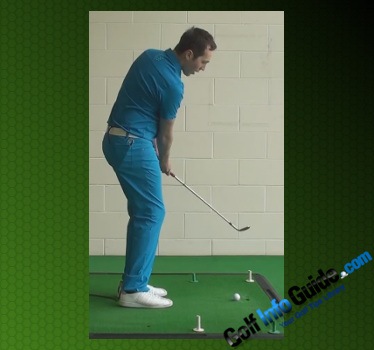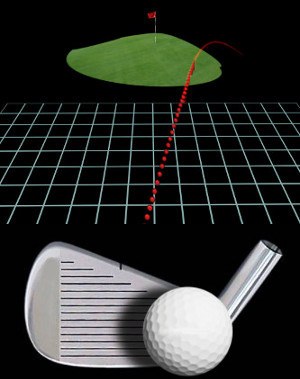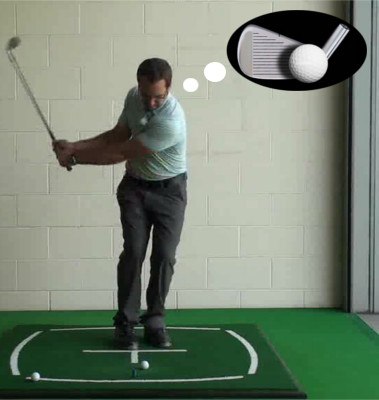In golf, some bad shots are worse than others.

Sure, you’d love to never hit any bad shots at all, but that simply isn’t going to happen. This is a difficult game, and bad shots are inevitably going to come along. When they do appear, you have to hope that they aren’t too damaging to your scorecard. If you can avoid making the big mistakes, you should be able to reach your goals on the course in time.
In this article, we are going to talk specifically about one kind of bad golf shot – the shanked chip. At first, you might think a shanked chip wouldn’t cause too much damage to your scorecard, since this is a mistake that happens within short range of the green. Obviously, you’d rather avoid this embarrassing mistake, but it can’t be too harmful to your score – right? Don’t be so sure. As an experienced golfer is sure to know, making the mistake of shanking a chip shot can actually lead to an ugly score on the card in short order.
Staying away from shanked chip shots is an important step in your development as a player. As long as you make solid contact when chipping, you should send the ball up toward the hole and have at least a chance to get up and down. You won’t get up and down every time, but making solid contact is a big step in the right direction. Once the threat of shanking your chips is pushed out of your mind as a result of solid technique and plenty of practice, you’ll be free to focus on producing the best possible shots while on the course.
All of the content below is based on a right-handed golfer. If you happen to play left-handed, please take a moment to reverse the directions as necessary.
How Does It Happen?

There is quite a bit of misunderstanding among amateur golfers when it comes to shanked shots in general, and that includes shanked chip shots. Like anything else, you need to have a firm understanding of this problem before you are going to be able to correct it properly. In this section, we are going to take some time to work through exactly what is happening when you shank a chip shot.
First, we need to stop and define a shank – basically, a shank is a shot that shoots immediately to the right after contact, and it usually fails to get off the ground by any significant margin. There are varying degrees of shanks, so some will head almost directly to the right after impact while scurrying along the ground, while others will not be quite so severe. No matter how bad a given shank happens to be, it’s quite likely you won’t be satisfied with the outcome of the shot when all is said and done. Rarely does a shank end with the ball coming to rest anywhere near your intended target.
It’s not hard to understand what a shank is, but there is plenty of confusion about how it happens. Some golfers seem to believe that since the ball shoots off to the right after impact, it must be that the ball struck the club way out on the toe. That would make some sense – but rarely is that actually the case. It’s possible to hit a shank off the toe, but it’s far more common to shank a shot in off the hosel. The hosel of your golf club is the portion of the club head where the club bends from the shaft out into the face. While all of the clubs in your set need to transition from shaft to club face in some way, the clubs with the most significant hosel feature are your irons. These are the ones that are most likely to be shanked, which is why shanking your chip shots can be a problem.
When you make contact with the ball on the hosel of your club, it is almost certainly going to shoot off to the right due to the shape of the hosel. So, even though you have hit the ball with the inside (or left side, looking down the line) of your club, the shot is going to travel well to the right of your intended target line. That is the case with a full swing iron shot just as it is the case with a chip shot. As mentioned above, it’s technically possible to shank the ball off the toe, but those kinds of shots are the exception. In this article, we’ll be focusing on hosel shanks, as those are by far the more common issue.
Okay – we now know that hitting a shank involves striking the ball on the innermost portion of the club head. When you think about that in terms of what it means for your golf swing, you can quickly understand that the club must be travelling through the hitting area too far away from your body. The center of the club face is a little too far away from you at impact, which is what allows the hosel to get involved. It might be that you simply need to bring the club in a little closer to you during the swing, or it might be that there is another technical issue standing in your way. We’ll get into the details of how you can straighten out your technique later on.
Finally, we want to quickly mention the margins at play here when talking about shanks. When you hit a shank, it feels like you have just played the worst shot in the history of golf. Not only does the ball fail to fly toward your target, the feeling that comes up through your hands at impact is less than pleasant. So, with such a nasty feeling shot, you may think that you aren’t even close to succeeding with your technique. But that’s not necessarily the case. Remember, the club face on your iron or wedge is not a particularly big space. Missing the sweet spot by just a couple inches is enough to lead you into shank territory. Even getting a fraction of an inch closer to the sweet spot – and away from the hosel – would allow you to avoid the shank and keep your round on the right track. Don’t be too hard on yourself when dealing with the shanks – improved play might not be as far off as you think.
Five Chipping Fundamentals

In the previous section, we worked through a discussion of what the shank is and how it happens. Now, we are going to bring the focus back specifically to chipping. If you are going to avoid the chipping shanks, a big part of what you need to do is use solid fundamentals from start to finish. If your technique is in great condition, there won’t be an opportunity for the shanks to work their way in and cause trouble.
Please take a moment to review the five chipping fundamentals listed below. If you can manage to include all five of these keys in your chipping technique, you’ll certainly be on the right track.
- Lean left. One of the biggest keys to hitting solid chips shots is to lean slightly left at impact when building your stance. This is not something that you would typically do when making a full swing, of course, but it works nicely when chipping. Basically, you are going to lean left as a way to establish a downward angle for your forward swing. Since you aren’t going to be making a big turn during this short little swing, your weight isn’t going to have a chance to get onto your left side – unless you start with it there and keep it there as the club swings. To be clear, we are not suggesting that you should place 90% of your weight on your left foot, or anything like that. This should be a subtle lean to the left, with maybe 55% or 60% on your left side. You should feel comfortable over the ball, and your stance should feel sturdy and stable.
- Hands in front of the ball. This second point works in coordination with the first point. Once you have set yourself up with your weight leaning toward your left side, make sure your hands are slightly in front of the ball at address. Then, when you make the swing and actually strike the ball, make sure your hands are once again ahead of the ball at impact. By combining a lean to the left with a forward shaft lean at impact (which is what happens when your hands are in front of the ball), you will hit down nicely, and you should be able to strike your chips cleanly over and over again.
- Keep the club moving. One common mistake that gives amateur golfers trouble when chipping is losing speed during the forward phase of the swing. If you have any doubt at all in your mind about the shot you are preparing to hit, you may struggle to keep the club moving aggressively toward the target. Without much confidence behind your swing, the tendency is to give up on the shot and attempt to guide the ball up toward the hole. During your practice sessions, work on building your confidence so you can keep the pace of your swing up properly even when facing a difficult chip.
- Steady eyes. Your eyes play a critical role in your chip shots. As you make your swing, be sure to keep your eyes trained on one specific spot on the golf ball. Consider drawing something unique on your ball and use that drawing as a point of focus (you may want to draw something on each side of the ball, so that one will always be facing up, no matter how your ball comes to rest). It will be tempting to look up early when making a chipping swing, in order to see where the ball is going. You need to remember that looking up early will not do you any good, so you might as well keep your eyes on the ball and wait to look up until after the shot has been struck.
- Maintain a firm left wrist. The last fundamental we want to highlight here is the firm left wrist. When you strike the ball on your chip shots, make sure your left wrist is as firm and flat as possible. Such a position is going to help you achieve a clean strike at impact, and it is going to make it easier for you to control the distance of your chip shots. If you flip your wrists through the hitting area, which will lead to a cupped left wrist position, the quality of your contact is going to suffer significantly. You’ll also struggle to control the distance of your shots if you let your left wrist hinge through the hitting area. To practice hitting with a firm left wrist, try chipping a few balls using only your left hand on the club. This is will be a tricky task to manage, but it will help you get comfortable with the feel of a proper impact position.
Don’t make the mistake of thinking that you will have no trouble at all checking off each of these five points in your own game. Chipping correctly is a challenge, and there is a good chance at least one or two of the fundamentals listed above is currently missing in your technique. Take some time to work on the points that give you trouble and your overall chipping ability will improve significantly. And, of course, if you are hitting solid chip shots time after time, your odds of a shank will go way down.
A Simple, Shank-Free Drill

The best way to move past the shanks when chipping is to solidify your technique. With that said, we want to also present you with a simple drill that you can use to help move the hosel of the club away from the ball at impact. Add this simple drill to your standard chipping practice routine to make sure you aren’t falling into any bad habits with regard to the position of the club head through the hitting area.
To perform this drill, please follow the steps listed below.
- You will first need to find a practice chipping area in order to work through this drill. Hopefully, your favorite local course offers such a space. If not, you may need to look around at other area courses in order to find a good place to work on your short game skills.
- Once you have a place to practice, the equipment you will need includes a wedge, a tee, and a few golf balls. That’s it. One of the best things about this drill is the simplicity of the setup and the limited gear required.
- To prepare for your first shot, place the tee in the ground at about the same height you would if you were hitting a driver. However, instead of placing the ball on the tee, you are going to place it next to the tee, on the inside (the side closer to you). When you place your club head down behind the ball to prepare for the shot, the tee should be just outside the toe of your club. In other words, if you swing through properly and hit the ball with the sweet spot, your club will miss the tee entirely.
- Once you have the setup complete, go ahead and hit a few chip shots. Your goal with each shot is simply to strike the ball cleanly while leaving the tee in place. If you are taking divots with these chip shots, you may need to move your tee every shot or two in order to find some new grass.
You have probably figured out how this drill can help you stay away from the shanks. If you do hit the tee when you swing through impact, that means the club head is too far away from you, and the hosel is dangerously close to the ball. This will serve as an excellent warning sign that something is wrong in your technique. Even if you aren’t hitting shanks in practice, the fact that you are contacting the tee during this drill is proof that you are cutting it close.
If you make it through this drill cleanly, take that accomplishment and use it as a big confidence boost moving forward. You now know that you are regularly making contact near the sweet spot with your chips, and you aren’t particularly close to hitting a shank. On the other side, don’t be too hard on yourself if you can’t make it through this drill properly just yet. Use this as an opportunity to address the problems that may be causing you to come close to a shank, so you can move your performance forward and leave shank worries behind.
The Mental Hurdle

Anyone who has dealt with the shanks previously knows that getting over the mental side of this issue is perhaps harder than anything else. Sure, there is some work to be done on the physical side of things to straighten out your technique, but that can be handled through persistence and attention to detail. On the mental side of things, however, it’s a bit harder to know how to move on.
The problem here is that shanks have a way of staying with you as a golfer. Even if you only shank a single chip shot during a round, it’s likely that you’ll remember that mistake long after the round is over. In fact, on future chip shots – even if they aren’t in the same round – you may find yourself thinking back to the shank you hit previously. This is a bad pattern to get into, of course, as thoughts of previous shanks aren’t exactly going to inspire confidence as you stand over the ball. You want to be thinking about producing a great shot, not worrying that you might strike the hosel and send the ball shooting off to the right.
So, how do you get over this big mental hurdle? With any question like this in golf, the answer always comes back to practice. As you work more and more on improving your technique, you’ll gradually build your confidence and forget about those shanks that you have hit in the past. The key word here is ‘gradually’. You shouldn’t expect this mental transformation to happen overnight. If you have recently been hitting some shanks when chipping, it will take a bit of time to forget about those errors and move on completely.
Each time you find yourself thinking back to a previous shank, stop and focus instead of what you have been doing in practice to achieve better chipping results. Think about the improvements you have made to your technique and think about all the good shots you’ve produced as a result. By trying to think about the good instead of the bad, you may be able to move away from fearing the shank and instead find yourself excited to conquer the challenge that each new chip shot represents.
It’s never fun to hit a shanked chip shot but doing so doesn’t mean you are destined to struggle with the short game for the rest of your golfing life. Most, if not all, golfers have hit a few shanked chip shots over the years. The key to improving in this game is to address your weaknesses, rather than running away from them. That holds true here – if you just ignore your shanked chip shots, it’s hard to imagine that your technique will magically improve. Take action in practice to improve the fundamentals of your chipping motion so you can be confident that the shanks are a thing of the past. Good luck!
 Rick Shiels – PGA Teaching Pro
Rick Shiels – PGA Teaching Pro
The shanked chip shot, the dreaded shank chip shot you’ve put it really close to the hole all you’ve got to do is hit the green and you put in for the par reducing your score and you end up knocking into a bunker and just messing up your hole. Let me give you a couple of really simple drills and tips to help you stop shanking these chip shots so the next time you play you are going to get it much closer to the hole.
Got a little station set up just here so I’ve got a few tee pegs and the golf ball in the middle, I’m going to explain to you why you shank your chip shots and how you can stop doing it. First thing make sure you are not still too close to the golf ball so a lot of players will get on top of the ball and when they come back in almost the legs are in the way and then they are pushing the club forward and it ends up here in the wrong side of the club, the heel, this section, they club too much. The other alternative is that the swing comes in to the ball and almost cuts across it too much and that’s one we are going to look at as well. So making sure we do it properly, first thing when we take our chip set up make sure our hands are below our chin and we’ve got enough space between ourselves and the club so that we are not going to restrict and almost block our entrance into the ball so that’s really important. Club down first and just get your hands just below your chin.
The next thing is the most common thing we see when we see a shank chip shot is the club will go back too much from the inside so it will go almost over that tee peg, it will loop over, it will come in from that green tee peg and because the club is coming in from such an obscured angle the heel part of the club just gets in the way and you end up kicking it off to the right and the more you hit it to the right the more you try and swing it more and more and more and more to the left and the more you shank it. So the normal movement is white tee, green tee and across, so you need to change that completely, you need to change that technique around that shot. You need to reverse it almost.
So instead of going back to the white tee you are going to feel that you are going back more to the green tee this one here just on the outside of the golf ball, you are going to get to the top of your swing then and just change the direction to come in more from that white tee to the white tee, so you reverse in that loop from before, nice distance away, you are going to make sure you go green, white and white. So that time when you come into your chip next time have a nice distance away, my hands are below my chin I’m going to go out and just a little motion back in and so then I’m hitting the middle of the golf club again and taking that opportunity to knock my next shot in. Work on that, practice that, no more shanked chips.





